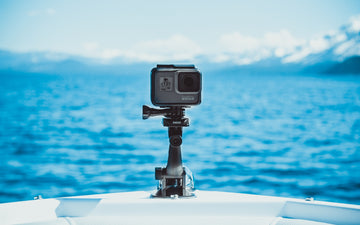What is an Action Camera? A Comprehensive Guide
Nov 23, 2023

In an era where capturing moments is more accessible and thrilling than ever, action cameras have gained immense popularity. Whether you're an adrenaline junkie, a travel enthusiast, or simply looking to document your everyday adventures, action cameras offer a compact and rugged solution for high-quality video and photography.
In this comprehensive guide, we'll explore the definition, key features, popular brands, technical specifications, accessories, advantages, limitations, selection criteria, maintenance, and much more to help you make an informed choice when considering an action camera.
What is the Definition of an Action Camera?
An action camera, as the name suggests, is a specialized type of camera designed to capture high-definition photos and videos in action-packed scenarios. These compact and durable devices are ideal for use in extreme conditions, making them the go-to choice for adventure seekers, athletes, and vloggers.
The defining characteristics of an action camera include its small and lightweight design, robust construction, and the ability to shoot in various modes, such as wide-angle, time-lapse, and slow motion. Action cameras are typically mounted on helmets, bikes, cars, and other equipment, allowing users to capture first-person perspectives and dynamic footage.
What are the Key Features of Action Cameras?
Beyond their compact and rugged exteriors, action cameras come equipped with a host of features that cater to the unique demands of thrill-seekers and adventurers. These cameras are designed to withstand extreme conditions and capture breathtaking moments. Here are the key features that make action cameras stand out:
- Compact Design: Action cameras are small and lightweight, making them easy to carry and mount on various surfaces.
- High-Quality Video: Most action cameras can record in high-definition (HD) or even 4K resolution, ensuring crystal-clear videos.
- Wide-Angle Lens: The wide-angle lens captures a broader field of view, which is perfect for action shots and landscapes.
- Durable and Waterproof: These cameras are built to withstand rugged conditions and are often waterproof, making them suitable for underwater adventures.
- Image Stabilization: Many action cameras come with built-in stabilization to reduce the shakiness of footage.
- Wi-Fi and Bluetooth Connectivity: These features allow you to control the camera remotely and share content quickly.
- Long Battery Life: Action cameras offer extended battery life to capture hours of footage.
These features collectively make action cameras the preferred choice for recording thrilling moments. Let's now explore the diverse use cases and scenarios in which action cameras excel.
Use Cases and Scenarios
Action cameras are known for their adaptability to various situations and environments, making them indispensable for a wide range of enthusiasts and creators. Here are some common scenarios where action cameras are used:
- Sports and Adventure: From mountain biking and skiing to skydiving and scuba diving, action cameras are essential for documenting extreme sports and adventures.
- Travel: Capturing stunning landscapes, local cultures, and unforgettable memories while on the go.
- Vlogging and YouTube: Many content creators rely on action cameras for creating dynamic vlogs and tutorials.
- Security and Surveillance: Some people use action cameras as dash cams or for home security.
- Underwater Exploration: Waterproof action cameras are perfect for snorkeling and deep-sea dives.
- Family and Social Gatherings: Lightweight and user-friendly, these cameras are great for documenting family events and parties.
Such variety of use cases illustrate the adaptability and appeal of action cameras. But before you choose the right one, it's essential to know which brands dominate the market. Let's explore the most popular action camera brands next.
What are Popular Action Camera Brands?
Several well-established brands dominate the action camera market, each offering a variety of models to cater to different needs and budgets. Some of the most popular brands include:
- GoPro: Known for setting the gold standard in action cameras, GoPro offers a wide range of models, from entry-level to professional-grade.
- DJI: Renowned for their drones, DJI has also ventured into action cameras with the DJI Osmo Action, which features dual screens and excellent stabilization.
- Sony: Sony's action cameras are known for their superb image quality and versatility.
- Insta360: Specializing in 360-degree cameras, Insta360 provides unique perspectives for action shots.
- Akaso: A budget-friendly option with a selection of cameras that offer good value for money.
- Yi Technology: Known for delivering high-quality action cameras at competitive prices.
Now that you are familiar with the leading brands, it's time to explore the technical specifications that matter when selecting the right action camera for your needs.
What are the Technical Specifications?
To choose the right action camera, it's essential to understand the technical specifications and features that align with your preferences and requirements. Here are some of the key technical specifications to consider:
- Resolution: Look for 4K capabilities for the best video quality.
- Frame Rate: Higher frame rates (e.g., 60fps or 120fps) allow for smoother slow-motion footage.
- Field of View (FOV): The wider the FOV, the more you can capture in your shot.
- Battery Life: Longer battery life ensures you don't miss any action.
- Storage Capacity: Ensure your camera supports the memory card size you need.
- Image Stabilization: This feature is essential for smooth video, especially in fast-paced activities.
- Connectivity: Check for Wi-Fi, Bluetooth, and compatibility with mobile apps.
- Waterproof Rating: If you plan on underwater adventures, make sure your camera is adequately rated for submersion.
Having a clear understanding of these technical specifications will help you make an informed decision when selecting the ideal action camera for your adventures.
What are the Accessories and Mounts?
The versatility of action cameras is greatly enhanced by the multitude of accessories and mounts available. These accessories cater to a wide range of shooting scenarios, allowing you to maximize the potential of your camera. Here are some of the essential accessories and mounts:
- Chest and head mounts: These provide unique perspectives, such as a first-person view.
- Suction cup mounts: Ideal for attaching your camera to vehicles and smooth surfaces.
- Tripods and selfie sticks: Essential for stationary shots or capturing yourself in the frame.
- Underwater housing: For deep-sea adventures, you'll need a waterproof housing to protect your camera.
- External microphones: To capture high-quality audio in noisy environments.
- Protective cases: Necessary for safeguarding your camera in rough conditions.
These accessories open up a world of creative possibilities, allowing you to capture your adventures from unique angles and viewpoints. Now, let's explore the advantages and limitations of action cameras.
What are the Advantages of Action Cameras?
Action cameras offer numerous advantages that make them invaluable for various scenarios:
- Portability: Their small size makes them easy to carry, mount, and handle.
- Durability: Designed to withstand harsh conditions, including water, dust, and impacts.
- Wide-Angle Shots: The wide field of view allows for immersive and dynamic footage.
- High-Quality Video: Most action cameras offer impressive video quality, often in 4K resolution.
- Versatility: Action cameras can be used in various scenarios, making them a valuable addition to your gear collection.
- Remote Control: Wi-Fi and Bluetooth connectivity enable remote control and live preview, enhancing the user experience.
- Stabilization: Many models come equipped with image stabilization to reduce shakiness in footage.
Now, let's explore the limitations of action cameras before looking into how to choose the right one for your needs.
Limitations of Action Cameras
While action cameras offer numerous advantages, they also come with some limitations:
- Limited Battery Life: Continuous recording can drain the battery quickly.
- Small Screen: The compact size of the camera limits the screen size, making it challenging to review footage on the device itself.
- Audio Quality: Action cameras often struggle with capturing high-quality audio, especially in noisy environments.
- Storage Capacity: 4K video files can be large, so you'll need ample storage space.
- Price: High-quality action cameras can be expensive, though budget-friendly options are available.
- Advanced Features: Entry-level models may lack some advanced features present in higher-end options.
Understanding these limitations will help you manage your expectations and make the most of your action camera. With this knowledge in mind, let's move on to the crucial process of choosing the right action camera for your specific needs.
How to Choose the Right Action Camera?
Selecting the right action camera depends on your specific needs and preferences. Here are some factors to consider:
- Budget: Determine how much you're willing to spend, as prices can vary significantly.
- Intended Use: Consider your primary use case, whether it's for sports, travel, vlogging, or general documentation.
- Video Quality: Look for 4K resolution if you want the best video quality.
- Battery Life: Consider how long you need the camera to last on a single charge.
- Waterproof Rating: If you plan on using the camera underwater, make sure it has the necessary waterproofing.
- Accessories: Check if the camera is compatible with the mounts and accessories you need.
- Brand Reputation: Research brands and read reviews to ensure product quality and reliability.
By following these steps, you can confidently choose the action camera that best suits your needs and preferences.
Maintenance and Care
Once you've selected your action camera, proper maintenance and care are crucial to keep it performing at its best. Here are some essential tips:
- Clean the Lens: Use a microfiber cloth to remove dirt, fingerprints, and water droplets from the lens.
- Update Firmware: Regularly check for firmware updates to improve performance and fix any issues.
- Protect the Housing: Keep the camera in its housing when not in use to protect it from dust and impact.
- Battery Maintenance: Charge and discharge the battery fully at least once a month to prolong its life.
- Store Properly: Store your camera in a cool, dry place away from direct sunlight.
With proper care, your action camera will continue to serve you well and capture your adventures for years to come.
Additional Resources
For more in-depth information and tips on using action cameras, you can visit AVC Store.
FAQs
Q1: What is an action camera used for?
A1: Action cameras are primarily used to capture high-quality photos and videos in action-packed scenarios, such as sports, adventure activities, and outdoor travel.
Q2: What is the difference between an action camera and a normal camera?
A2: Action cameras are designed for rugged, outdoor use and offer features like waterproofing, wide-angle lenses, and durability. Normal cameras are more versatile but may not be as rugged or suitable for action-packed situations.
Q3: What is the disadvantage of an action camera?
A3: Some disadvantages of action cameras include limited battery life, small screens, and challenges with capturing high-quality audio in noisy environments.
Q4: Can you use an action camera as a normal camera?
A4: While action cameras excel in capturing action shots and adventure footage, they can be used as normal cameras for everyday photography and videography, although they may have some limitations compared to dedicated point-and-shoot or DSLR cameras.




